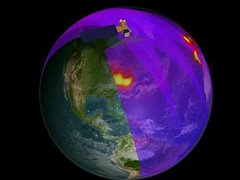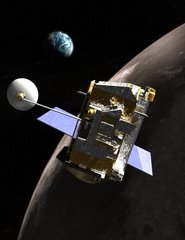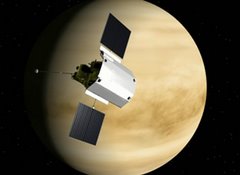
The
Lunar Reconnaissance Orbiter is the first step in NASA's return to the moon. LRO will launch in late 2008 with the objectives to finding safe landing sites, locate potential resources, characterize the radiation environment, and demonstrate new technology. I'm the Education and Public Outreach (EPO) lead for LRO. I'm using
twitter to provide updates of the LRO Project Science Working Group (PSWG) that is taking place at Goddard Nov 28-30. You can follow my tweets here or in realtime at
twitter.com/geosteph.Project Manager Craig Tooley is doing the "State of the Project" overview. The current launch date is October 28 2008. Greetings from the Lunar Reconnaissance Orbiter (LRO) Project Science Working Group meeting...live from NASA Goddard Space Flight Center!
Learn more about LRO at http://lro.gsfc.nasa.gov/ check the progress of the spacecraft assembly at http://lro.gsfc.nasa.gov/ha...
Link to instruments http://lro.gsfc.nasa.gov/in... and pics http://www.flickr.com/photo...
Craig just mentioned the Bruce Springsteen road crew tour." I got the most interesting technical questions from this group" during the tour
60 Minutes, BBC, Discovery, WETA, NPR Canada have all been out to capture LRO on film
Next up Joanne Baker with the LRO Orbiter Lever Integration and Test presentation
Joanne is talking about what instrument teams can expect during the integration of their instruments to the spacecraft.
All the instruments be tested before they are integrated...environmental tests ..vibe, thermal vac, acoustics and shock, EMC

new avatar FlatSat - mock up of where instruments go on LRO...in prep for instrument integration
RIck Saylor is discussing the Mission Operations Center--the MOC is where LRO will be commanded and controlled after launch
The LRO MOC is in buidling 32 at Goddard...right next door to my building
The MOC also receives LRO telemetry and data and processed and distributes data to the instrument Science Operations Center-- the SOCs
Stan Scott is now speaking about the LRO Data Working Group. The group includes LRO folks and instrument team members
So, each instrument has a Science Operations Center..that processes it's own data after receiving it from LRO;
Within six months the LRO instrument data is provided to NASA's Planetary Data System (PDS) http://pds/index.html
All NASA Planetary missions are required to deliver data to PDS w/in six months of data acquisition by the instrument teams.
 LRO instruments CrATER http://lro.gsfc.nasa.gov/cr... - effects of the lunar radiation environment on tissue equivalent plastic
LRO instruments CrATER http://lro.gsfc.nasa.gov/cr... - effects of the lunar radiation environment on tissue equivalent plastic
LEND measures the flux of neutrons on the moon..http://lro.gsfc.nasa.gov/le... is the Russian contribution to LRO
 LEND will use neutron flux to determine hydrogen concentration on the lunar surface - looking for possible sources of water
LEND will use neutron flux to determine hydrogen concentration on the lunar surface - looking for possible sources of water
Next up is LOLA..the Lunar Orbiter Laser Altimeter... http://lro.gsfc.nasa.gov/lola.html
 LOLA will make 140 measurements/second. measures range to surface (topography) surface slope, surface reflectance and surface roughness
LOLA will make 140 measurements/second. measures range to surface (topography) surface slope, surface reflectance and surface roughness
Reflectance measurements may allow LOLA to "see" water ice in the permanently shadowed regions on the Moon
LOLA PI Dave Smith " ...a negative rock would be a hole" as LOLA 'sees' it
LOLA will do laser ranging-Earth Based laser tracking stations will range to LRO via LOLA for improved LRO timing and orbit determination
 The LRO camera is up now with PI Mark Robinson http://lro.gsfc.nasa.gov/lr..
The LRO camera is up now with PI Mark Robinson http://lro.gsfc.nasa.gov/lr..
LROC has a wide angle and narrow angle camera.. LROC's measurement objectives are here: http://lroc.sese.asu.edu/ob.
LROC's narrow angle cameras will give us 25x better image resolution than the current lunar data sets
Diviner will measure lunar surface temperatures at scales that provide information for future surface operations and exploration
Diviner will map global day and night temperatures http://lro.gsfc.nasa.gov/di
LAMP is the Lyman-Alpha Mapping Project http://lro.gsfc.nasa.gov/la... UV from starlight to see in shadowed regions on the Moon
 The LAMP instrument is an exact copy of the Alice instrument on New Horizons http://pluto.jhuapl.edu/spa...
The LAMP instrument is an exact copy of the Alice instrument on New Horizons http://pluto.jhuapl.edu/spa...
The LAMP website has a great summary of the search for water on the moon: http://www.boulder.swri.edu...
Now a talk on the LRO launch window: there are 2 opportunities to go to the moon each day...

Launch window is 2-3 days every two weeks that gives us the optimal lunar orbit
Discussion from LOLA PI Dave Smith about what LRO will do in it's science phase after year 1
LRO's nominal orbit is 50 Km above the lunar surface.
Dave says we will know the topography and gravity field very well after the first year of operations..so we could lower the orbit to 5-10 km
we will find the highest point on the moon when we hit it-eventually LRO will run out of fuel & will have an abrupt landing
Check out the LRO promo http://tinyurl.com/2f8cb9
 The Lunar Reconnaissance Orbiter is the first step in NASA's return to the moon. LRO will launch in late 2008 with the objectives to finding safe landing sites, locate potential resources, characterize the radiation environment, and demonstrate new technology. I'm the Education and Public Outreach (EPO) lead for LRO. I'm using twitter to provide updates of the LRO Project Science Working Group (PSWG) that is taking place at Goddard Nov 28-30. You can follow my tweets here or in realtime at twitter.com/geosteph.
The Lunar Reconnaissance Orbiter is the first step in NASA's return to the moon. LRO will launch in late 2008 with the objectives to finding safe landing sites, locate potential resources, characterize the radiation environment, and demonstrate new technology. I'm the Education and Public Outreach (EPO) lead for LRO. I'm using twitter to provide updates of the LRO Project Science Working Group (PSWG) that is taking place at Goddard Nov 28-30. You can follow my tweets here or in realtime at twitter.com/geosteph.LRO instruments CrATER http://lro.gsfc.nasa.gov/cr... - effects of the lunar radiation environment on tissue equivalent plastic
LEND will use neutron flux to determine hydrogen concentration on the lunar surface - looking for possible sources of water
LOLA will make 140 measurements/second. measures range to surface (topography) surface slope, surface reflectance and surface roughness
The LRO camera is up now with PI Mark Robinson http://lro.gsfc.nasa.gov/lr..
The LAMP instrument is an exact copy of the Alice instrument on New Horizons http://pluto.jhuapl.edu/spa...







No comments:
Post a Comment